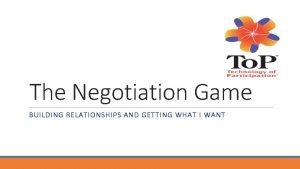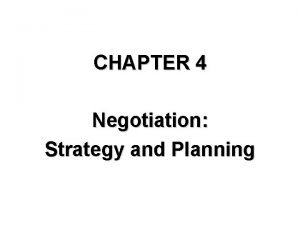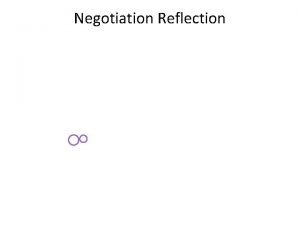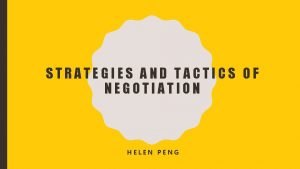Planning for Negotiation Helen Peng CONTENTS Game plan






- Slides: 6

Planning for Negotiation Helen Peng

CONTENTS • Game plan A negotiation plan consists of three stages, there are: a. Pre-negotiation planning b. During negotiation behavior and c. Post-negotiation understanding

PRE-NEGOTIATION PLANNING u Know thyself: Evidence shows that people who have lesser tolerance for ambiguity tend to be losers in negotiation. u Know the adversary Women tend to be more conciliatory than man; the famine-oriented students were found to be less deceiving than the masculine-oriented. …cultural differences do make a difference in the negotiating styles of individuals. u Specify your goals and objective: u. Be to clear as to what are your immediate and long-term objectives in the negotiation. . It is absolutely necessary to priorities your objectives. . Or combine into a single package u Develop arguments/alternatives: what would be a tolerable limit without losing much u Agenda/procedures: uwhat issues/items on which negotiation has to take place…. . physical arrangement like seating arrangement at the venue. Seating arrangement=body language. Time frame for negotiation should be identified…decision are taken usually towards the end of the closing period of time.

DURING NEGOTIATION BEHAVIOR Ø Opening Move: If the parties in negotiation are meeting for the first time, the opening move becomes very important. The basic idea of the opening dialogue is to put the other individual/party at ease and to help in settling down. Too conservative or too liberal an offer can prolong the process of negotiation. Ø Negotiation Dance: based on two elements- frequency of proposals and size of proposals. Frequency refers to the number of times proposal are made and size refers to the quantity/value of the proposals. **The time for closing the deal approaches, the frequency of concessions increases-called monotone decrease. ** A negotiation dance also deals with las-clear chance offer, a tendency to reach the maximum limit and then to say “take it or leave it” Ø Influence mechanisms 1. Referent Power: Dropping names negotiation settlement. with these people should be taken into account in the 2. Expert Power: It refers to using their expertise on the issues or using jargon unfamiliar to other individual/party, thereby indicating that they know more about the issue and hence their point of view is the best.

POST-NEGOTIATION UNDERSTANDING IT REQUIRES A BLUE PRINT TO PUT THE AGREEMENTS IN ACTION. • Implementation Plan: • including the course of action, resource generation and resource utilization, a time table and indices for monitoring, and evaluation of the success of the course of action taken. • Role Responsibilities: • Helping in allocating responsibilities, authority, and accountability to save time and energy by avoiding unnecessary duplication of efforts and streamlines the need for coordination between the two individuals/parties in negotiation. • Review Teams: • These individual/parties should ensure adequate information sharing, provide timely feedback, make mid-course correction, and by and large make sure that progress is timely and as planned.











